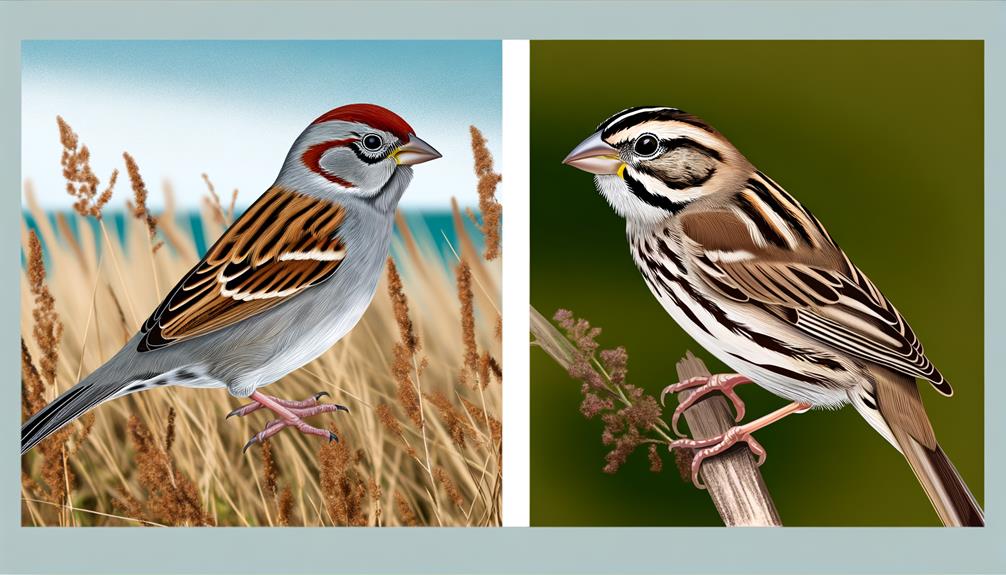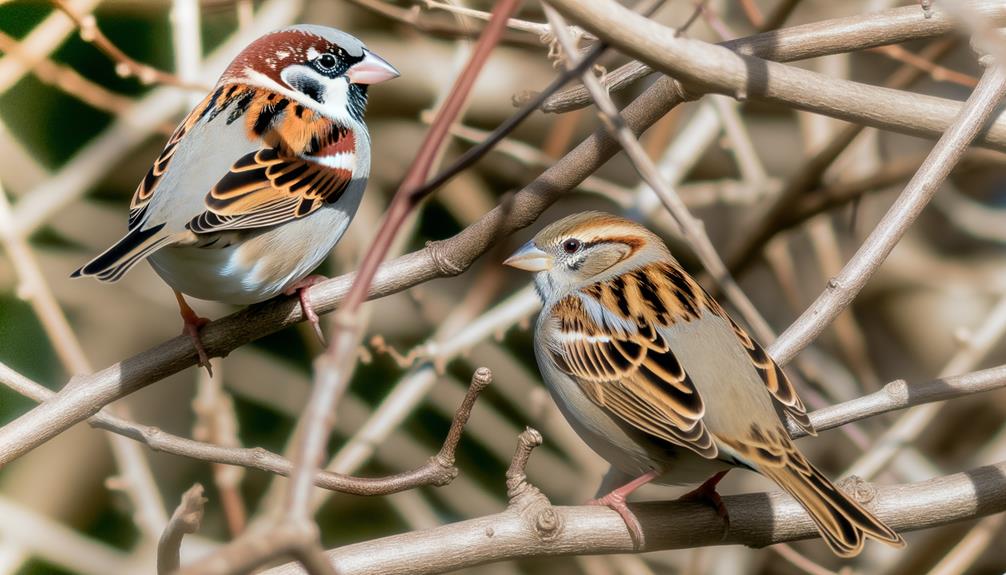Field Sparrow Vs Vesper Sparrow: 7 Key Differences
The Field Sparrow and Vesper Sparrow, both members of the Passerellidae family, are identifiable by their distinct physical traits and behaviors. Field Sparrows exhibit a delicate form with a pinkish bill, grayish face, and warm, rusty brown plumage, featuring a clear white eye-ring.
They prefer open grasslands with scattered shrubs and nest in concealed, ground-level sites. Vesper Sparrows, with more varied foraging strategies, typically occupy open fields and pastures, showing longer migration patterns.
Their songs, characterized by clear whistles and buzzy trills, differ considerably from the Field Sparrow's simpler, accelerating trills. To discover more nuances of their fascinating behavior, keep exploring.

Key Takeaways
- Field Sparrows have a pinkish bill and distinctive white eye-ring, while Vesper Sparrows do not.
- Field Sparrows nest in old fields and shrubby areas, whereas Vesper Sparrows prefer open grasslands and agricultural fields.
- Vesper Sparrows incorporate more insects into their diet, especially during breeding, compared to the primarily seed-eating Field Sparrows.
- Field Sparrows have a simple, rhythmic song, whereas Vesper Sparrows sing a more complex and varied melody.
- Field Sparrows undertake short-distance migrations, while Vesper Sparrows migrate longer distances, sometimes reaching Central America.
Physical Characteristics

When comparing the physical characteristics of the Field Sparrow (Spizella pusilla) and the Vesper Sparrow (Pooecetes gramineus), one immediately notes the distinctive differences in their plumage, size, and markings.
The Field Sparrow exhibits a more delicate, compact form with a pinkish bill, grayish face, and a distinctive white eye-ring. Its plumage is generally a warm, rusty brown with a plain breast.
In contrast, the Vesper Sparrow is larger, with a streaked breast and distinctive white outer tail feathers. It features a less pronounced eye-ring and a more robust, conical bill.
Both species possess specific adaptations that contribute to their identification, making each unique within their respective ecological niches.
Habitat Preferences
The Field Sparrow typically favors open grasslands with scattered shrubs for nesting, while the Vesper Sparrow prefers habitats that combine open fields and lightly grazed pastures.
Both species exhibit distinct seasonal migration patterns; Field Sparrows migrate short distances within North America, whereas Vesper Sparrows undertake longer migrations, often crossing into Central America.
These habitat preferences and migration behaviors play vital roles in their ecological niches and survival strategies.
Preferred Nesting Sites
Field Sparrows and Vesper Sparrows exhibit distinct habitat preferences. Field Sparrows typically select old fields and shrubby areas, while Vesper Sparrows favor open grasslands and agricultural fields.
Field Sparrows build their nests on or near the ground, often concealed by dense vegetation such as grasses or low shrubs. They utilize natural depressions to provide additional camouflage.
In contrast, Vesper Sparrows prefer nesting in grassy fields, often choosing sites with sparse vegetation to avoid predators. Their nests, also ground-based, are typically more exposed but benefit from the surrounding open terrain.
Both species exhibit remarkable adaptability to their selected environments, optimizing nest placement to enhance survival and reproductive success. Their contrasting choices reflect their unique ecological niches.
Seasonal Migration Patterns
As the seasons change, both Field Sparrows and Vesper Sparrows exhibit distinct migration patterns that correspond closely with their habitat preferences. Field Sparrows typically migrate to the southeastern United States, favoring grasslands and shrubby areas. In contrast, Vesper Sparrows migrate to the southwestern United States and Mexico, preferring open fields and prairies.
| Species | Winter Habitat Preferences |
|---|---|
| Field Sparrow | Grasslands, Shrubby Areas |
| Vesper Sparrow | Open Fields, Prairies |
| Field Sparrow | Southeastern United States |
| Vesper Sparrow | Southwestern U.S., Mexico |
| Field Sparrow | Shorter Migration Distance |
This divergence in migration destinations and habitat preferences highlights the ecological adaptations each species has developed to thrive in their respective environments during the winter months.
Feeding Habits

While both species mainly consume seeds, Field Sparrows exhibit a preference for smaller grass seeds, whereas Vesper Sparrows frequently incorporate a higher proportion of insects into their diet, especially during the breeding season.
Field Sparrows forage mainly on the ground, utilizing their conical bills to extract seeds from grasses and forbs. They often feed in open fields and meadows, showing a notable affinity for weedy habitats.
Conversely, Vesper Sparrows display a more varied foraging strategy, including ground-feeding and occasional aerial insect pursuit. Their diet is enriched with beetles, caterpillars, and grasshoppers during the warmer months, which are essential for chick development.
This dietary flexibility highlights the Vesper Sparrow's adaptability to fluctuating food availability in diverse habitats, ensuring their nutritional needs are met year-round.
Vocalizations
Both Field Sparrows and Vesper Sparrows exhibit distinct vocalizations. Field Sparrows produce a series of clear, whistled notes that accelerate into a trill. This song is characterized by simplicity and rhythmic acceleration, providing a steady, rising cadence. On the other hand, Vesper Sparrows are known for their melodious song that includes a mix of clear whistles and buzzy trills. These songs are more complex, incorporating varied frequencies and tones. The Vesper Sparrow's song often begins with a few introductory notes that serve as an auditory marker, setting the stage for the main sequence.
Such vocal distinctions are essential for species identification and understanding ecological interactions. They offer insight into the behavioral ecology and communication strategies of these birds.
Breeding Behavior

Field Sparrows display monogamous breeding behavior, typically forming pair bonds that last throughout the breeding season. They construct their nests close to the ground, often hidden by grasses or shrubs. Females lay 3-5 eggs per clutch, with both parents sharing incubation responsibilities. Vesper Sparrows, on the other hand, prefer open fields for nesting and also maintain monogamous relationships during the breeding season. Their nests are well-concealed, often in hollows on the ground, lined with fine grasses. Both species exhibit strong territorial behavior, defending their breeding sites vigorously.
| Species | Nest Location | Clutch Size | Incubation Sharing |
|---|---|---|---|
| Field Sparrow | Near ground, concealed | 3-5 | Yes |
| Vesper Sparrow | Ground hollows | 3-5 | Yes |
Both species' dedication to their breeding territories safeguards the safety and survival of their offspring.
Observation Tips
To effectively observe Field Sparrows and Vesper Sparrows, enthusiasts should focus on their preferred habitats, utilizing binoculars and field guides for accurate identification. Field Sparrows favor open fields with scattered shrubs, while Vesper Sparrows prefer grasslands and agricultural areas.
Observers should note distinguishing features: Field Sparrows have unstreaked chests and a distinctive white eye ring, whereas Vesper Sparrows exhibit a white outer tail feather and faint chest streaking. Early morning or late afternoon are ideal observation times due to increased avian activity.
Listening for their unique songs can also aid in identification—Field Sparrows emit a clear, descending whistle, while Vesper Sparrows produce a series of musical trills. Maintain a respectful distance to minimize disturbance.
Conclusion
To sum up, while both the field sparrow and vesper sparrow share some similarities, their distinct physical traits, habitat preferences, and behaviors set them apart.
Field sparrows prefer open fields and meadows, whereas vesper sparrows favor grasslands and prairies. Each species has unique vocalizations and breeding habits.
When observing these sparrows, remember: 'The devil is in the details.' Paying close attention to their subtle differences will enhance your birdwatching experience and deepen your understanding of these fascinating creatures.






